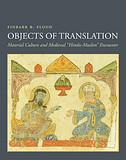Objects of Translation
Flood, Finbarr Barry:
Objects of translation : material culture and medieval "Hindu-Muslim" encounter / Finbarr B. Flood. - Princeton : Princeton University Press, 2009. - xv, 366 S. : Ill., Kt.
ISBN 978-0-691-12594-7 / 0-691-12594-5
US$ 45,00 / £ 30,95
Beschreibung
Objects of Translation offers a nuanced approach to the entanglements of medieval elites in the regions that today comprise Afghanistan, Pakistan, and north India. The book - which ranges in time from the early eighth to the early thirteenth centuries - challenges existing narratives that cast the period as one of enduring hostility between monolithic "Hindu" and "Muslim" cultures. These narratives of conflict have generally depended upon premodern texts for their understanding of the past. By contrast, this book considers the role of material culture and highlights how objects such as coins, dress, monuments, paintings, and sculptures mediated diverse modes of encounter during a critical but neglected period in South Asian history.
The book explores modes of circulation - among them looting, gifting, and trade - through which artisans and artifacts traveled, remapping cultural boundaries usually imagined as stable and static. It analyzes the relationship between mobility and practices of cultural translation, and the role of both in the emergence of complex transcultural identities. Among the subjects discussed are the rendering of Arabic sacred texts in Sanskrit on Indian coins, the adoption of Turko-Persian dress by Buddhist rulers, the work of Indian stone masons in Afghanistan, and the incorporation of carvings from Hindu and Jain temples in early Indian mosques. Objects of Translation draws upon contemporary theories of cosmopolitanism and globalization to argue for radically new approaches to the cultural geography of premodern South Asia and the Islamic world. [Verlagsinformation]
Inhalt
Acknowledgments. xi
A Note on Translations and Transliterations. xv
INTRODUCTION. 1
Roots or Routes? 1
Networks, Translation, and Transculturation. 5
Things and Texts. 9
CHAPTER 1: THE MERCANTILE COSMOPOLIS. 15
Polyglot Frontiers and Permeable Boundaries. 15
Gifts, Idolatry, and the Political Economy. 26
Heteropraxy, Taxonomy, and Traveling Orthography. 37
CHAPTER 2: CULTURAL CROSS-DRESSING. 61
Prestigious Imitation. 61
Fractal Kingship and Royal Castoffs. 75
The Raja's Finger and the Sultan's Belt. 84
CHAPTER 3: ACCOMMODATING THE INFIDEL. 89
Sunni Internationalism and the Ghurid Interlude. 89
From King of the Mountains to the Second Alexander. 93
Homology, Ambiguity, and the Rule of Sri Hammira. 107
CHAPTER 4: LOOKING AT LOOT. 121
Signs of Sovereignty. 121
Looting and Difference. 123
Trophies and Transculturation. 126
CHAPTER 5: REMAKING MONUMENTS. 137
Taxonomies, Anomalies, and Visual Pidgin. 137
Rupture and Reinscription. 152
Noble Chambers and Translated Stones. 160
Patrons and Masons. 184
Markets, Mobility, and Intentional Hybridity. 189
CHAPTER 6: PALIMPSEST PASTS AND FICTIVE GENEALOGIES. 227
A World within a World. 227
Monuments and Memory. 247
The Fate of Hammira. 255
Conclusion: In and Out of Place. 261
Appendix: Principal Dynasties and Rulers Mentioned. 269
Notes. 271
Bibliography. 311
1. Primary Sources. 311
2. Secondary Sources
(a) History and Material Culture. 317
(b) Conceptual and Theoretical. 347
Index. 353
Autor
FINBARR B. FLOOD is associate professor in the Department of Art History and the Institute of Fine Arts at New York University. He is the author of The Great Mosque of Damascus: Studies on the Making of an Umayyad Visual Culture. Profile page.
Quellen: Princeton University Press; WorldCat; Amazon.

